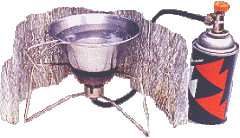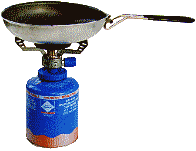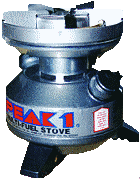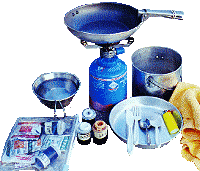Chapter 19
Stoves and Cooksets
Fuels
Screens Comparisons
Recommendations
Cooksets Tips
CAMPING TRAVELERS WILL save money and eat better by carrying a source of instant fire. With this method
some can experience Europe for $15 per
day, plus transport. You can cook eggs the way you like, make soups and stews, and call up
a hot drink at any time. You can combine efforts with neighbors to create a gourmet meal,
or one that seems so at the time. The money saved should afford
occasional feasts of local cuisine at restaurants.1
Note that some campgrounds and most hostels have cooking facilities available.
- Isobutane
- Butane and twenty percent propane which is sold in light steel canisters. It has
replaced straight butane since it ignites in outside air temperatures down to about 15º F
(-10º C). It is the most convenient and clean-burning fuel for normal conditions since
you just strike a match and turn on the stove.
- Isobutane is mainly sold in two incompatible formats: canisters manufactured by Camping
Gaz-Bluet, a French company that dominates the gas stove market, and more or less industry
standard canisters sold by EPI (British), Primus (Swedish), MSR and Coleman (American),
and Olicamp (Chinese).
- Gaz-Bluet fuel canisters are practically everywhere in continental Europe, widely
available in outdoor shops in the U.S., Canada, Britain, Australia, and New Zealand, and
somewhat available in sixty-two other countries. In France, where the canisters are also
widely used for lanterns and heaters, you can cheaply buy them in grocery stores.
- Industry standard canisters are slightly more available than Gaz-Bluet canisters in
Britain, Australia, and New Zealand. In my overall experience, however, most shops that
carry industry standard canisters also have Camping-Gaz, while the reverse is less true.
- Butane
- Same characteristics as isobutane, except it won't ignite if the outside air temperature
falls below freezing.
- Propane
- A gas that must be contained in heavy steel canisters, making it suitable only for car
and RV camping.
- White Gas
- Also known as Coleman fuel and Blazo, white gas is a hot and relatively clean-burning
gasoline. Widely available in the U.S., Canada, Europe, Australia, and New Zealand in
outdoor shops and some hardware stores.
- Unleaded Gas
- Available wherever modern cars run. Additives in fuel are noxious (injurious to health).
Stoves and pans will require frequent cleaning.
- Leaded Gas
- Produces very noxious fumes, not recommended as a fuel. Will clog the jets on stoves
quickly.
-
- Kerosene
- Available worldwide, this is the chief heating and lighting fuel for developing
countries. Cheap, but often of such a low grade it should first be filtered through a
cloth. More difficult to light than gasoline, especially in cold weather. Usually the
stove must be "primed"--the burner is initially heated with a flame from
preheating paste, gasoline, or paper. Kerosene is also dirtier, smellier, and smokier than
white gas, and it blackens pots.
-
- Jet Fuel and Stoddard Solvent
- Similar to kerosene.
- Diesel
- Stove combustion byproducts of this heavy fuel are noxious, enormous, and
immediately cancel
out ten years of broccoli.
- Alcohol
- Coolest burning fuel with one-half the heat output per weight of any of the above. May
be difficult to find in the 200 proof variety. I don't recommend alcohol-only stoves for
travel.
Even a slight breeze greatly reduces stove efficiency as the windscreens
built into stoves are always insufficient. Make a windscreen from four feet of aluminum
foil by folding it over a few times until you have a piece approximately six inches high
by twenty-four inches long (15x60 centimeters) that just or mostly surrounds your stove.
Attach a few paperclips for later anchoring and rigging. Or create from a large pie plate.
Or spend $10 to $29.95 for a pre-made contraption at your outfitter.
Be aware you don't want to heat up the fuel bottle or canister with the
windscreen.
| Illustration: Scorpion model I stove, industry
standard isobutane canister, sierra cup, and aluminum windscreen. |
 |
Tents, Cooking, Fire, and Carbon Monoxide
- Gaz-Bluet 470HP, Turbo, and Micro
- $30, 8 oz. (225 g.) All are light, compact, very convenient, and have excellent fuel
availability in Europe. They simmer well, burn hot, and pop on either a CV 270 or 470 gram
isobutane canister ($3 and $4.50, two and four hours burn-time on medium) making heat
instantly available for your pleasure. The convenience of these stoves is unbeatable--you
flick your lighter and turn the valve. No spare parts necessary.
 |
Illustration: Gaz-Bluet 470HP stove, 470 gram propane/butane
cartridge, and non-stick fry pan. The folding handle was so long it tipped the fry pan at every opportunity. Hence
I finally ripped it off and now use a pot gripper, which saves weight and works okay, as
pictured below. |
- While Gaz-Bluet makes several stoves compatible with CV270 and CV470 cartridges, beware
the Gaz-Bluet model 206 stove. It uses an old-style cartridge which is punctured by the
stove, and therefore must remain attached to the stove until empty. The 206, while cheap,
is inefficient and, in my opinion, dangerous.
- Olicamp Scorpion
- $25, 8 oz. (225 g.) This nifty Taiwanese stove (a very good simmerer) uses industry
standard fuel canisters. The model III has a large built-in windscreen that is less
effective than the the lighter and more compact Scorpion model I with external screen
pictured above.
- Other stoves that use industry standard canisters
- are sold by EPI, Primus, MSR (RapidFire only), and Coleman (some models only). Most
would work reasonably well for travel.
- Beware
- Hank Roberts and certain models of Optimus stoves which use incompatible canisters (but
at first glance may look standard) that can be difficult to find. These are specialty
stoves for souls who willfully suspend themselves thousands of feet up sheer mountain
faces and concurrently want to relax with a cup of hot chocolate.
- MSR XGK
- $90, 15.5 oz. (440 g.) Like all MSR stoves, includes windscreen, pump, and stuff sack,
requires fuel bottle. Operates on white gas, auto gasoline, kerosene, jet fuel, diesel,
Stoddard solvent #4, and AV gas. Burns very hot and very loudly, like a blow torch. It
doesn't simmer. (For all practical purposes it's either on or off.)

- The XGK is a proven design used on expeditions for melting snow and boiling water. It
has a large-diameter generator tube which resists clogging. This is the most omni-fuelish
stove, and it cleans easily. Spare parts and repair kit, $10. Mountain Safety Research is
based in Seattle.
- MSR Dragonfly
- $100, 17 oz. (480 g.) A new product that reportedly burns all the fuels of the XGK, but
simmers better.
- MSR Whisperlite Internationale 600
- $60, 14 oz. (400 g.) Burns white gas and with a change of a jet, kerosene. Burns hot.
More compact, quieter, and slightly better at simmering than the XGK. Cleans easily. Spare
parts and repair kit, $10. Don't confuse this stove with the MSR Whisperlite, which burns
white gas only.
- Sigg Fire Jet
- $70, 13 oz. (370 g.) Burns white gas, gasoline, and kerosene, but simmers about as well
as most other multi-fuel stoves. Sigg is a Swiss company best known for quality camping
cookware.
-
 Coleman Peak1 Multi-fuel
Coleman Peak1 Multi-fuel
- $65, 21 oz. (600 g.) Burns white gas, kerosene, and jet fuel. Has a built-in
twelve-ounce fuel tank, which runs on high for ninety minutes. Not as compact for a given
burn time as other designs, but is a proven product. Coleman stoves simmer better than
other multi-fuel designs, and require little or no priming. Due to weight and bulk,
however, the pictured stove is better for hunters than travelers
- Zipstove Sierra
- $43, 15 oz. (425 g.) Burns wood or charcoal. A single AA battery powers a fan
which intensifies the heat. It works. Some love it, some hate it. One Appalachian Trail
hiker hated hunting twigs every time he needed fire, as this is a busy stove.
Others consider the Zipstove a magnificent invention, with fuel available everywhere.
Blackens pots and your hands.
- Optimus and Primus
- Stoves by these Swedish companies were oft-carried by travel backpackers/explorers from
the end of the last century until about 1980. While Primus has moved to gas stoves,
Optimus still manufactures remarkable relics with the 8R/Hunter
and SVEA/123R models.
For travel backpacking/camping throughout the developed world I recommend a newer model
Camping Gaz-Bluet or industry standard gas
stove. Advantages include space, gravity, and convenience.
When I wake up after a late night what I want from my stove is to flick, turn, and cook
or kick back. I never want to deal with the pumping, priming, lighting, relighting,
monitoring, adjusting, fiddling, cleaning, and stowing rituals of gasoline and kerosene
stoves.
When I need more fuel I'll pick some up at the camp store or the next time I pass an
outdoor shop.
Furthermore, gas stoves burn so cleanly they leave nothing on the bottom of your pots,
unlike sooty gasoline and kerosene stoves which also heavily pollute that all-important
local environment below your nose.
Overall I give an edge to Gaz-Bluet fuel canisters over the so-called industry standard
for worldwide availability and lower price.
The MSR XGK, as the most omni-fuelish stove, is
recommended for camping in remote areas and developing countries where fuel supply is
likely to be a problem, or for expeditions that will be boiling lots of water or melting
snow for drinking.
While this stove simmers about as well as a Saturn V rocket, it is matchless for
producing a reliable, hot flame from many different fuels. It is also extreme overkill for
European campgrounds at six in the morning.
 For one or two people a one- to two-liter pot should handle all the pasta and
soups you can eat. (A one-liter pot is just barely adequate.) I use a light eight-inch (20
cm.) non-stick fry pan for much of my cooking. It cleans with an easy wipe, which is a big
plus after a big feed.
For one or two people a one- to two-liter pot should handle all the pasta and
soups you can eat. (A one-liter pot is just barely adequate.) I use a light eight-inch (20
cm.) non-stick fry pan for much of my cooking. It cleans with an easy wipe, which is a big
plus after a big feed.
Every cooking camper should have a sierra cup, which is stainless steel and has a wire
around the rim that quickly cools the rim. Sierra cups are great for heating water for tea
and coffee, as well as sauces, vegetables, and soups. You can cook a lot with just these
three items. I also carry a light aluminum plate for use as a lid, and for guests.
For utensils I carry a knife, fork and spoon. My knife and fork are made from Lexan,
which saves an ounce. Note that Lexan melts if left in the fry pan (although this led to
one of my greater inventions--the spife). Some diehards travel with only a spoon,
and use their Swiss army knife for cutting and buttering.
- Coleman Peak 1 Solo cookset, two-quart pot and fry pan, stainless steel, $20, 12 oz. (340
g.)
- MSR pot and fry pan, stainless steel, $40, 14 oz. (400 g.)
- titanium cookset, strong, light, and so costly you're afraid to leave a simple pot lying
around, $55, 5 oz. (140 g.)
- generic two-quart aluminum pot (what I use), $6, 6 oz. (170 g.)
- 8 in. (20 cm.) non-stick fry pan, Open Country brand (what I use), $10, 7 oz. (sans
handle, 200 g.)
- aluminum or plastic plate (or Frisbee), 2 oz. (57 g.)
- knife, Lexan plastic, $1, 0.5 oz. (14 g.)
-
 fork, Lexan
plastic, $1, 0.5 oz. (14 g.)
fork, Lexan
plastic, $1, 0.5 oz. (14 g.)
- spife, an evolutionary new utensil, 0.4 oz. (11 g.)
- spoon, stainless steel, 1 oz. (28.35 g.)
- pot gripper (secures with a squeeze, very useful, pictured at right), $3, 1oz. (28.35 g.)
- sierra cup, 8 or 12 oz. (250 or 375 ml.) capacities, $4.50, 4 oz. (110 g.)
- lighter, cheap plastic butane, 0.5 oz. (14 g.)
- two GI-style can openers, zilch
- nylon pot scrubber, zilch
- spicebag, a plastic zip bag holding smaller bags or containers of salt, pepper, garlic,
hot pepper, crushed onion, Italian seasoning, etc., 4 oz. (110 g.)
- teabag, a plastic zip bag filled with a variety of tea or coffee, for yourself and new
friends, 3 oz. (85 g.)
Travelers' Tips
When traveling in China bring your own utensils or buy your own plastic chopsticks
because poorly washed or even unwashed wooden chopsticks are a leading cause of sickness
there. Jennifer, Vancouver
How to See the World is copyright © John Gregory 1995-2009. All rights reserved. Except
for personal use like showing to a friend, it may not be reproduced, retransmitted,
rewritten, altered, or framed. All
product names and trademarks are property of their respective
owners. Comment.
Sales.
Disclaimer. Thank you.
............
.
|
|
. |
. |
....... .
. |
.. |
.. |
. |
.`
|
| ....... |
:)
. |
. |
. |
..... |
.. |
.. |
. |
. |
| . |
. |
|
. |
. |
. |
|
. |
. |
| . |
|
. |
. |
...............
. |
. |
. |
|
. |
| |
. |
. |
. |
......................................... . |
. |
. |
. |
|
| ......
.............. |
. |
. |
. |
ARTOFTRAVEL.COM
.
|
. |
|
(: |
..
.
.
......... . |
| . |
. |
. |
. |
. |
. |
. |
. |
. |
Notes
1. Also, there are still a few places in the world, including Norway,
where fish leap into the pan for
free and tasty meals. back



 Coleman Peak1 Multi-fuel
Coleman Peak1 Multi-fuel For one or two people a one- to two-liter pot should handle all the pasta and
soups you can eat. (A one-liter pot is just barely adequate.) I use a light eight-inch (20
cm.) non-stick fry pan for much of my cooking. It cleans with an easy wipe, which is a big
plus after a big feed.
For one or two people a one- to two-liter pot should handle all the pasta and
soups you can eat. (A one-liter pot is just barely adequate.) I use a light eight-inch (20
cm.) non-stick fry pan for much of my cooking. It cleans with an easy wipe, which is a big
plus after a big feed.  fork, Lexan
plastic, $1, 0.5 oz. (14 g.)
fork, Lexan
plastic, $1, 0.5 oz. (14 g.)